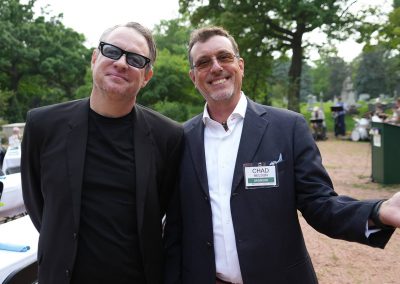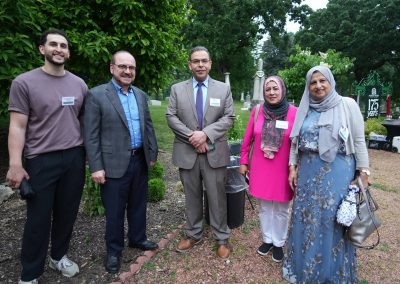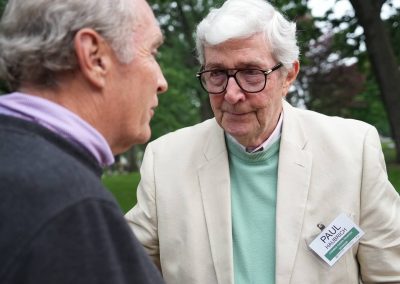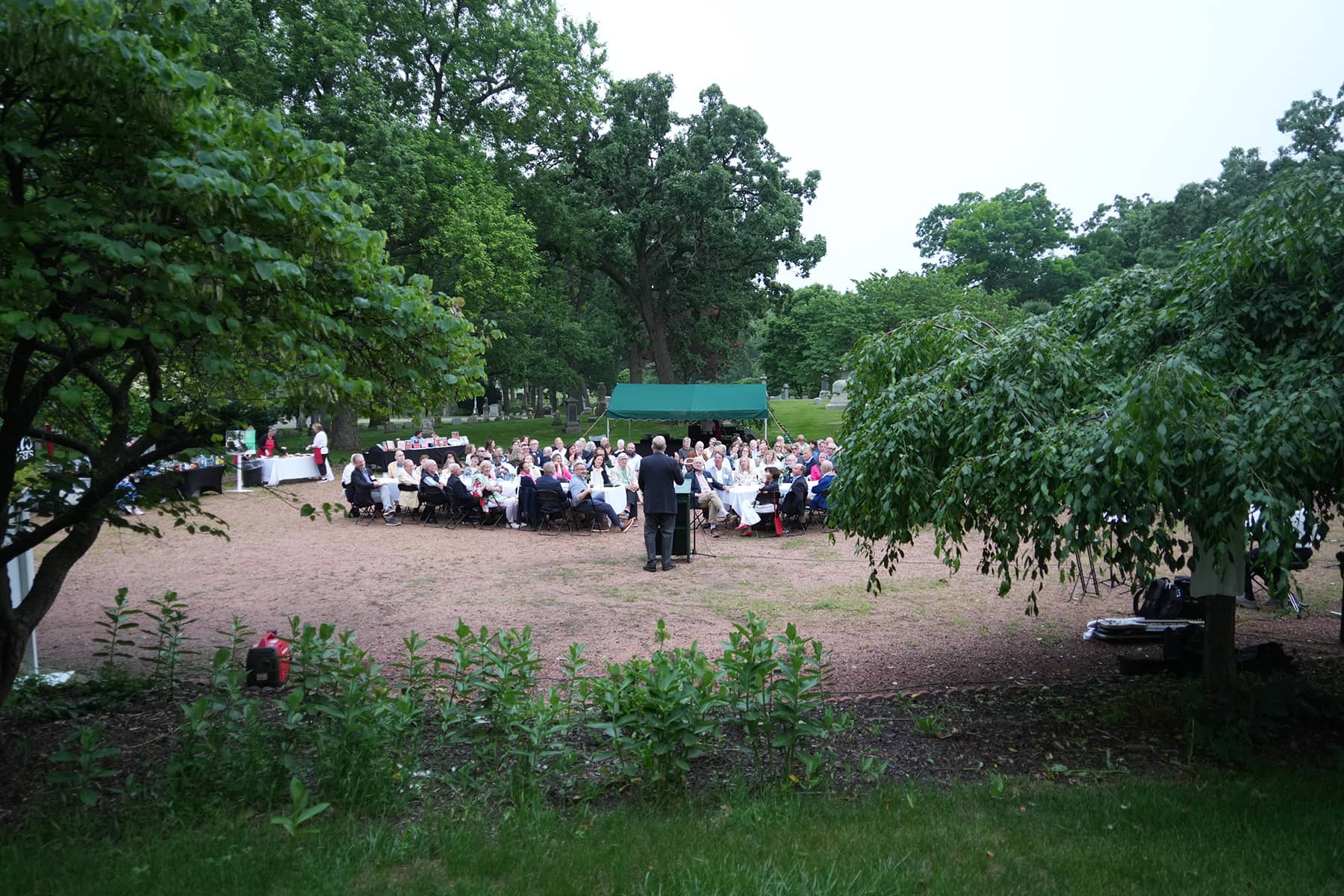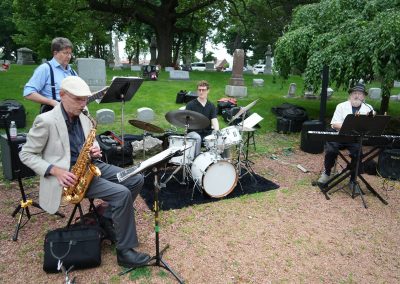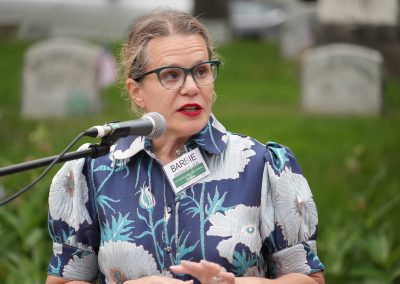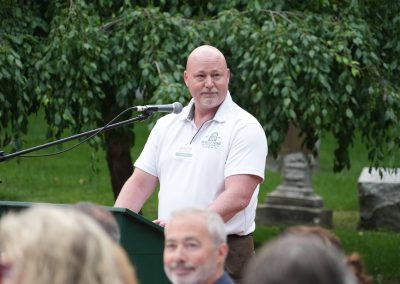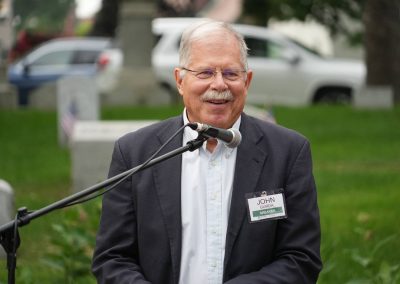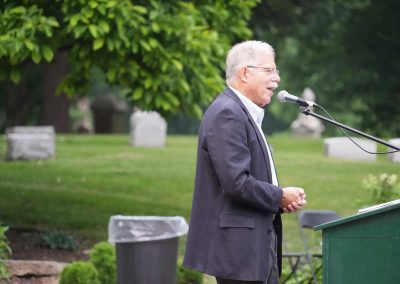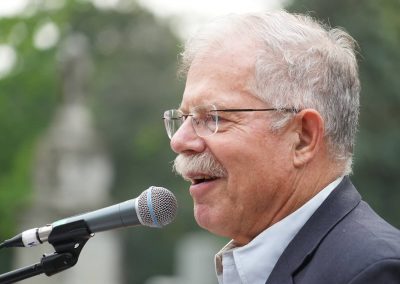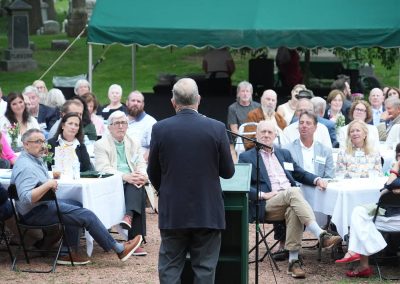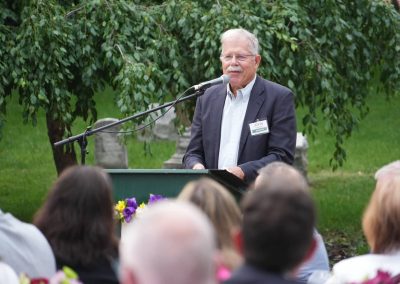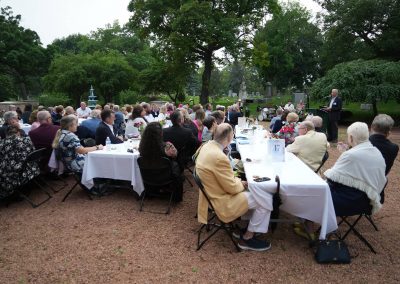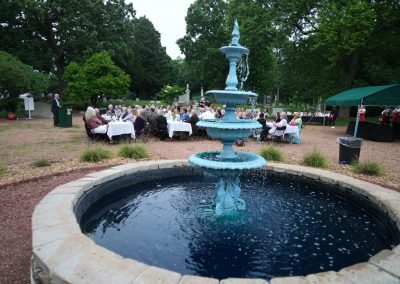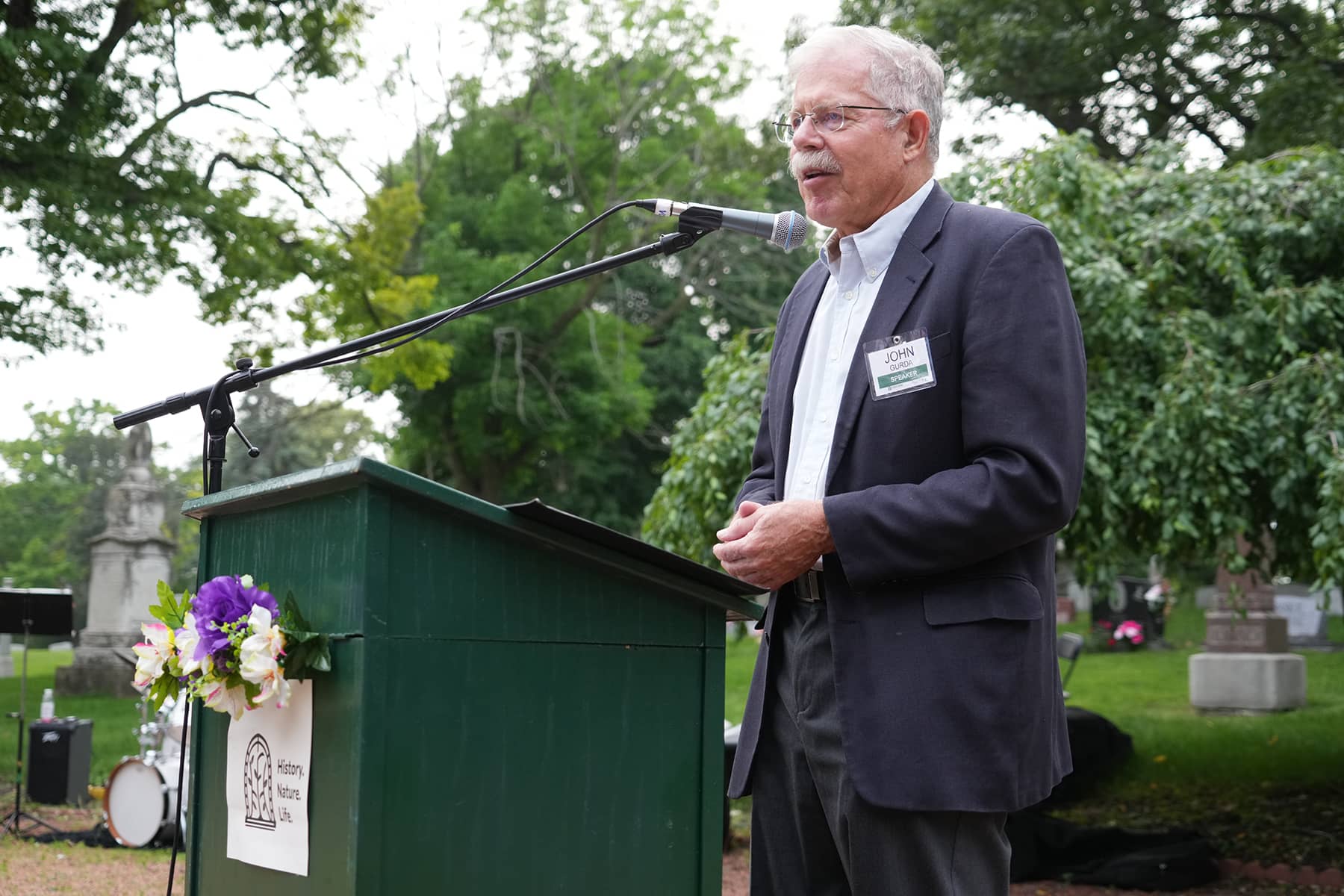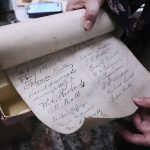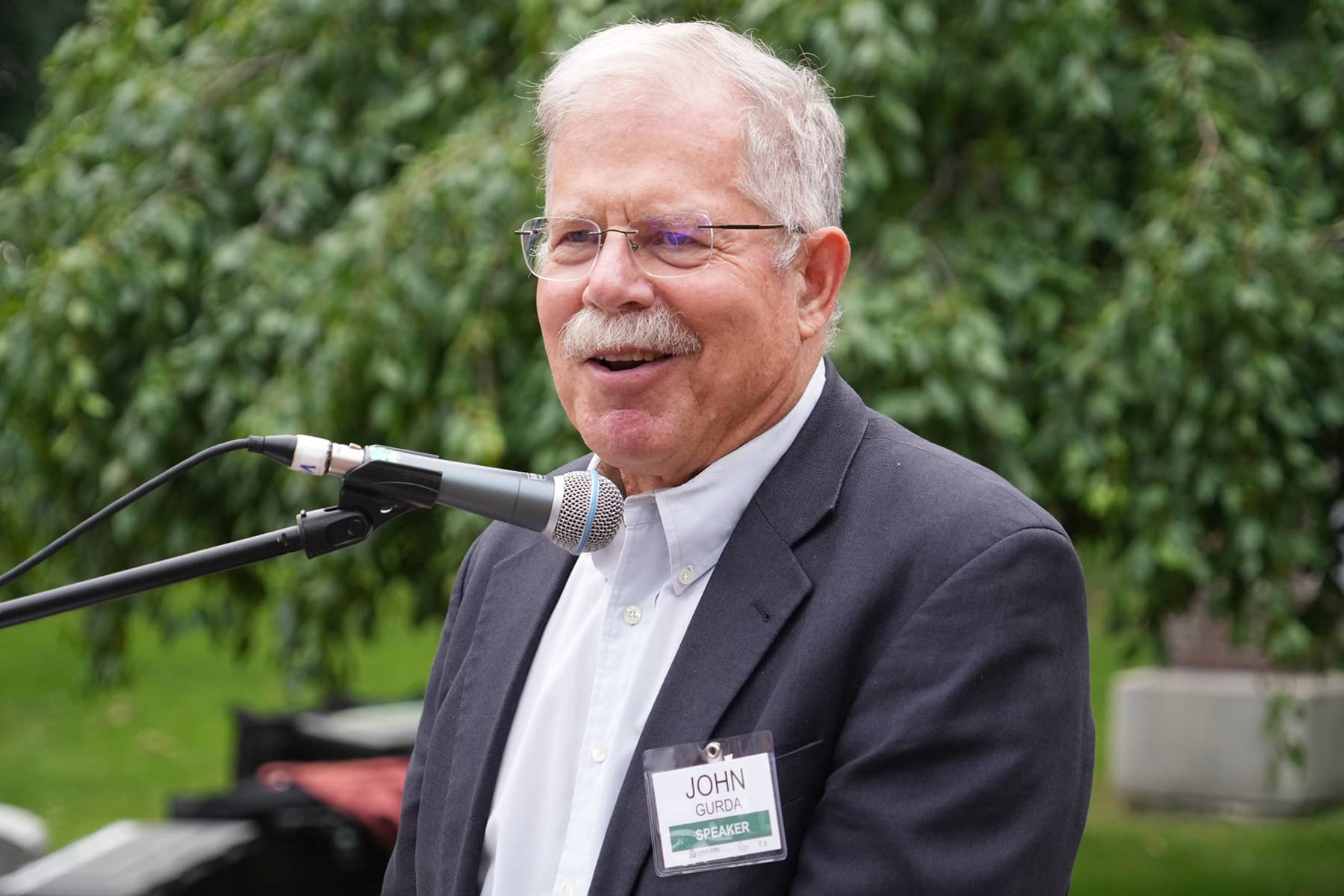
Beneath the sweeping canopy of century-old trees and towering monuments, Forest Home Cemetery celebrated its 175th anniversary on June 25.
The evening gala featured a keynote address by celebrated historian John Gurda, who has spent decades chronicling Milwaukee’s past. He also counts himself among the future residents of the city’s most storied burial ground.
“This may be my last chance to talk in both my first and my last neighborhood,” Gurda said.
Gurda grew up on South 34th Street, just blocks from the cemetery, and recalled the landscape of his childhood stretching between Forest Home and Jackson Park. He remembered wandering to the Drews Drive In store near the 29th Street Branch Library, long before modern concerns about child safety changed how children moved through the world.
“We spent a lot of time in Jackson Park, but not much in Forest Home,” Gurda said. “It was vaguely Protestant. I didn’t know what that meant back when I was eight, but I knew it wasn’t Catholic.”
His connection deepened over time, especially after graduating from Boston College and returning home to explore Milwaukee’s South Side as a historian.
“Local history became my passion and the foundation of what became a career,” he said. “And I became a South Side historian first, sort of a South Side loyalist for a long time.”
Just before the gala, Gurda said that he wandered the cemetery grounds looking for George Walker’s grave, the city founder behind Walker’s Point. Though he had visited the obelisk before, weathering had erased much of its inscription.
“Over time, I came to see Forest Home as by far the richest repository of history in the entire Milwaukee area,” Gurda said.
In 1997, Gurda was commissioned to write a formal history of the cemetery titled “The Silent City” for its 150th anniversary. He returned in 2022 to revise the work for its updated edition, incorporating a new generation of discoveries and developments.
And now, a full 25 years later, he has personally chosen Forest Home as his final resting place.
“The obvious choice was right here at Forest Home,” Gurda said. “And the obvious place was Prairie Rest.”
Preferring green burial over traditional methods, Gurda acknowledged his personal approach with signature humor.
“The prospect of embalming left me cold,” he said, “and I could not warm to the idea of cremation.”
Forest Home’s origins trace back to 1850, when members of St. Paul’s Episcopal Church, still located today in the city’s affluent Yankee Hill neighborhood, sought a more dignified alternative to the crude displacement of early pioneer graves.
“The founders, the faithful of St. Paul’s Episcopal Church, decided to end that sacrilege in 1850 by opening what they called a cemetery for the city,” Gurda said.
The land, 73 wooded acres along the old Janesville Plank Road, was purchased from the family of Reverend Lemuel Hall and chosen for its rolling terrain, well-drained soils, and bucolic setting just beyond the city’s edge.
“They were after what they called the picturesque,” he said. “The model there was and is Mount Auburn in Cambridge, Massachusetts.”
Forest Home quickly became Milwaukee’s premier cemetery. By 1872, the street that once led to it was renamed Forest Home Avenue. Gurda said there was no other street in Wisconsin that had been named for a cemetery.
“Forest Home became Milwaukee’s cemetery of choice. It was the most beautiful, the most prestigious, and the most popular burying ground in Milwaukee,” Gurda said.
It also became a playground of sorts, a destination for Sunday family outings in an era when green space was scarce. In 1889, when Milwaukee’s entire park system totaled just 125 acres, Forest Home accounted for 116 of them.
“Milwaukeeans could not get enough of it,” he said. “Sunday was the only day they had off, and this cemetery was packed with families enjoying some relief from the clamor and congestion of the larger city.”
Transportation also helped make that possible. In 1857, a horse-drawn wagon-like coach offered 10-cent roundtrips from downtown. By 1877, a steam-powered “dummy train” ferried passengers along iron rails from 1st and Mitchell to the cemetery gates.
A stuffed mule was put on the front of that small locomotive as a decoy, meant to avoid spooking the horses still common on city streets. The site grew into a showcase for Victorian landscape design, sculpture, and horticulture.
As visitors increased, so did the ambition of its monuments. Some plots became extravagant displays of wealth and status.
“It was a monumental exercise in one-upmanship,” Gurda said. “Obelisks and pyramids, crosses, columns, spheres, they sprouted like mushrooms after a rain.”
Among the more spectacular tributes was the 84-ton granite pillar erected by liquor wholesaler Emil Schneider in 1894. But it was brewer Emil Blatz who outdid them all two years later with a 500-ton mausoleum, complete with marble interior and a tiled ceiling.
“It’s still very imposing,” Gurda said. “It stood right across the road from monuments to the Schlitz and Pabst families.”
Even the nickname “Brewers’ Quarters,” one of the most memorable sections of the cemetery, reflected the city’s social map in stone.
“A friend said it looks just like the South Side,” Gurda said. “It was no different than street corners, with Pabst and Blatz saloons.”
Forest Home’s rise as a symbol of civic identity was not limited to the wealthy or the well-known. From the beginning, its purpose was broader than prestige.
“This has always been a cemetery for the city, a cemetery for everyone,” Gurda said.
While early burials were dominated by Milwaukee’s Anglo-Protestant elite, the grounds gradually reflected the city’s ethnic and religious mosaic. German, Scandinavian, and Black Milwaukeeans all found space within its borders. Although the affluent commissioned the grandest tributes, ordinary families made the cemetery their own.
“There was a full-time staff here of at least 50 people,” Gurda said. “They created a splendid setting for all these private monuments.”
By the late 19th century, Forest Home was a self-contained environment blending art, nature, and public ritual. It featured artificial ponds, ornate fountains, and 17 miles of carriage paths and walkways. The greenhouse operation produced more than 135,000 flowers each year, many destined for individual gravesites. The cemetery even kept animals on site.
“There were deer, a flock of peacocks, fish in the pond, it was a small-scale zoo as well,” Gurda said.
The development was guided by prominent figures in Milwaukee’s architectural and civic history. The 1892 landmark chapel was designed by Ferry & Clas, the firm behind the Milwaukee Central Library and the Pabst Mansion. The 1909 office building was the work of Alexander C. Eschweiler, while the cemetery’s landscaping for more than 40 years was shaped by James Currie, a Scotsman who also led both the city and county park commissions.
“Currie Park is named in his honor,” Gurda noted.
As the 20th century advanced, Forest Home’s prominence declined somewhat. It was in part because Milwaukee finally committed to building its public park system, and in part because the cemetery was surrounded by new neighborhoods. Even Gurda’s grandparents were part of that demographic shift.
“All these Poles and Germans moved out from the old section of town and kind of surrounded Forest Home Cemetery,” he said.
Still, the cemetery remained a barometer of changing tastes and practices in American burial. The 1920s brought the lawn plan, which prioritized ease of mowing over vertical headstones. Later additions included memory gardens and above-ground crypts. More recently, Forest Home has embraced green burial and columbaria – cremation vaults.
“Contrary to popular belief, there is still room for thousands of burials here,” Gurda said. “And they’re some of the most affordable in the city.”
Today, Forest Home is not just a place of rest. It is a space of active memory. In 2014, ownership transitioned from St. Paul’s to a nonprofit organization it created, that would be dedicated to preserving its mission as a civic and historical asset.
“In 1850, a group of Milwaukee Episcopalians decided to create a cemetery for the city,” Gurda said. “Their vision produced a burial ground that is part arboretum, part stonecutter showcase, and all local history.”
The legacy, he added, lies not just in landscape and architecture, but in intention.
“The people responsible for Forest Home have shown a consistent commitment to a singular vision,” he said. “The founders saw this cemetery as an institution that would operate as a public trust, providing security for the families of its residents and a beauty spot for the entire metropolis.”
That commitment still echoes today.
In 2023, a Forest Home tour docent revisiting historical maps noticed references to ancient Indigenous mounds. Working with the Ho-Chunk Nation and the Wisconsin state archaeologist, the cemetery confirmed the presence of at least two burial mounds. The earthworks that had been hidden in plain sight for generations.
“They were sort of gentle hillocks, so they kind of blended in,” Gurda said.
Rather than disturb them, the cemetery’s original designers had arranged lots in concentric circles around the mounds. Some of Forest Home’s most famous names — including Harry Bradley, William Pitt Lynde, and Jane Pettit — are interred near those preserved sites.
“That survival was startling,” Gurda said. “If you think about it from a broader perspective, those earthworks, at least a thousand years old, have reemerged as a poetic message from the distant past.”
For Gurda, the discovery affirmed a deeper truth: that Forest Home had always been a place for lasting remembrance, across cultures and centuries.
“…As if to affirm that Forest Home has always been a perfect place for final rest and lasting remembrance,” added Gurda. “From time immemorial to a future beyond imagining, the silent city endures.”

